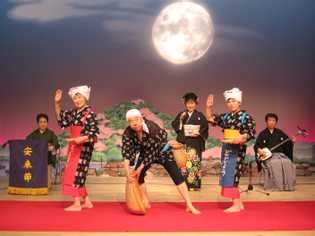安来節 その一 - Yasugi Bushi 1 (Song of Yasugi)
The Yasugi Bushi is one of the most difficult and popular folksongs in Japan. It requires a special technique to sing it and singers have to go from very high tones to very low tones, at almost the same time, to sing it properly. Every year, there is a contest to determine who is most proficient at singing this famous song. It is indeed a stirring melody and the Japanese enjoy it immensely. Foreign visitors hearing it for the first time are astonished at the great range of vocal changes included in the song. They admire the singer for his or her ability.
安来節は日本において最も知られ、同時に最も難しい民謡の一つに数えられます。歌いこなすには特別な技量を必要とし、ほぼ同時に高音から低音まで発声しなければなりません。毎年、この有名な民謡を誰が最も上手く歌えるかを競う大会が催されます。起伏に富んだ旋律に人々は酔いしれ、安来節を初めて聞いた外国人は、その幅の広い音域の変化に驚き、歌い手の力量に対し賞賛を惜しみません。
Originally, it was sung as entertainment for boatmen from the seaports on the Japan sea during the latter part of Edo Era, from about 1830 to 1844. Many other folksongs were combined with it. Finally, a restaurant owner in Yasugi, Sahei Watanabe, a proficient musician, developed the Yasugi Bushi into thestandard Yasugi Bushi we have today. His daughter, Oito, sang the Yasugi Bushi when she was eight years old. She had a beautiful voice and it made her famous.
元来、この歌は江戸時代末期の一八三〇年から一八四四年にかけて、日本海各地の港からやって来た船乗り達を迎える為に歌われていましたが、他の多くの民謡と混ざり合い、安来で料亭の主人でもあった優れた音楽家、渡部佐平衛の手により今日我々が耳にする安来節へと変化を遂げました。佐平衛の娘、お糸は八歳から安来節を歌い始め、彼女の名はその美しい声と共に広まって行きました。
Later on, Tokunosuke Tomita, a popular shamisen player joined her. The background music of the shamisen is a very important part of the song and during the Meiji Era, the way of playing shamisen and singing the song used to be very free and flexible. Now it is fixed.・ As the song and Oito’s singing to Tokunosuke’s playing became more popular, they felt the need to protect the original character of the song, and formed the “Orthodox Yasugi Bushi Preservation Society” in 1911. At that time, formal rankings were established for the singers.
その後、お糸は当時名を馳せていた三味線奏者富田徳之助と手を組みます。三味線は安来節で重要な位置を占めており、現在は定型化されている三味線の演奏方法と安来節の歌唱方法は明治時代にはかなりの裁量が許容されていました。安来節と、徳之助の三味線に合わせてお糸が歌うという形が多くの人々に受け入れられて行くに連れ、二人は安来節本来の姿を保護する必要性を感じ、一九一一年、「正調安来節保存会」を結成します。これを機に、歌い手には正式な等級が付けられる様になりました。
From that time, after the Taisho Era, it became fixed and is now taught and sung in a standard way. However, it is still flexible to some extent and the emotions of the singer can affect the song. Sadness, humor, happiness and almost any other feeling can be expressed by the person singing it.
大正時代以降、安来節は定形化され、それが歌い継がれ今日に至っています。しかし、現在でも歌い手の気持ちを歌に込める点ではある程度の裁量は許容されています。安来節は喜怒哀楽を始めとする人間のあらゆる感情を表現し得る歌なのです。
Shimane Prefecture had a Cultural Fair in New York City in June, and the Yasugi Bushi was played there. My friend Mr. Randy Quinby, attended to the performances and told me that he had became homesick for Shimane. He also told me that the exhibition hall was so full that no more people could get in. Many were standing, but all of them were charmed by the fantastic culture of Shimane Prefecture. Maybe some of them will visit us. I hope so.
島根県は去る六月、ニューヨークで島根文化祭を開催し、そこで安来節も披露されました。公演を見に来ていた友人のランディ-・クインビー氏は、島根が懐かしいと言っていました。彼の話では、会場はこれ以上入れないというほど満員で、立見の人も多く、誰もが島根の素晴らしい文化に魅了されていたという事です。彼らが島根を訪れてくれる事を願います。
